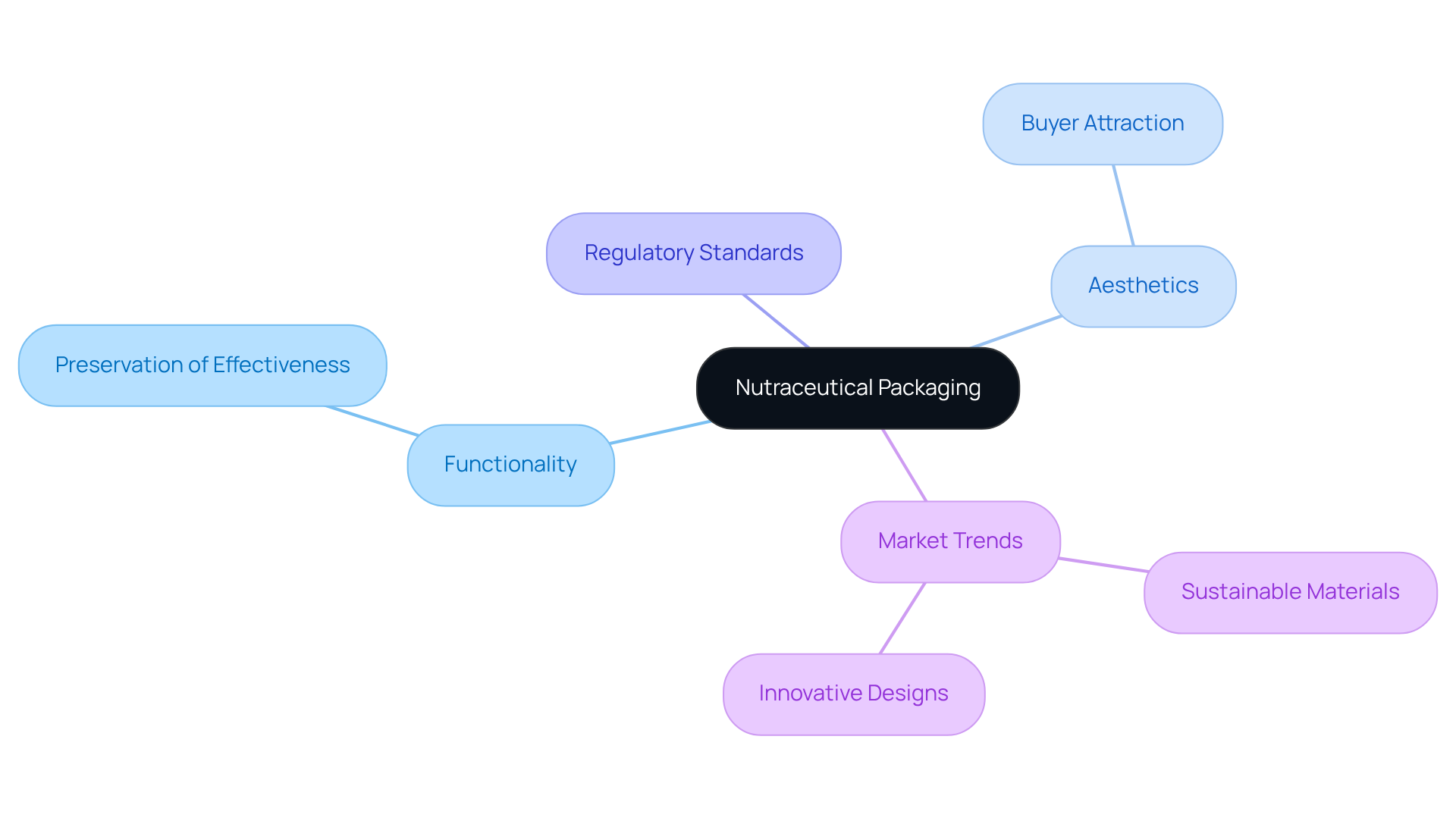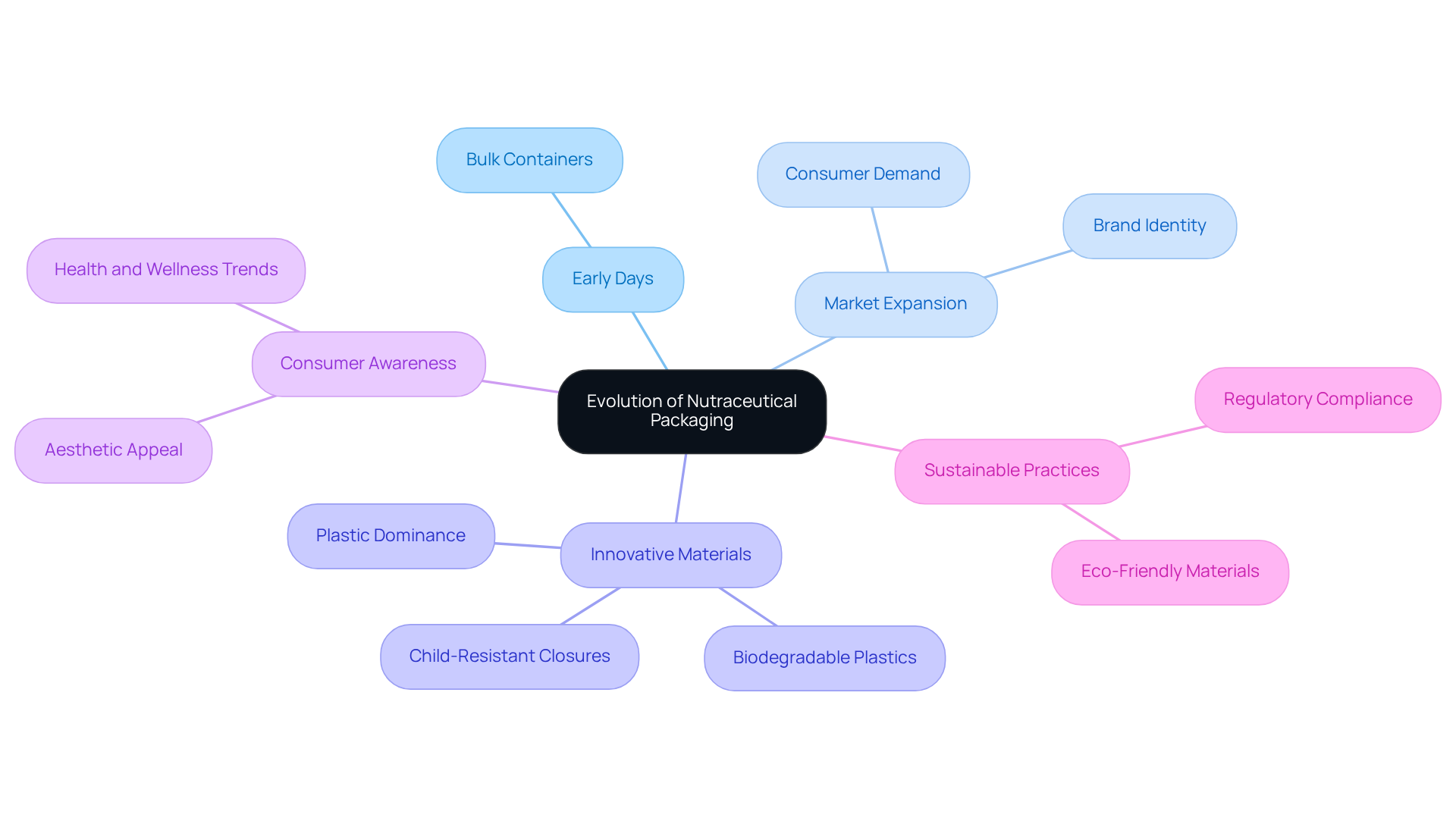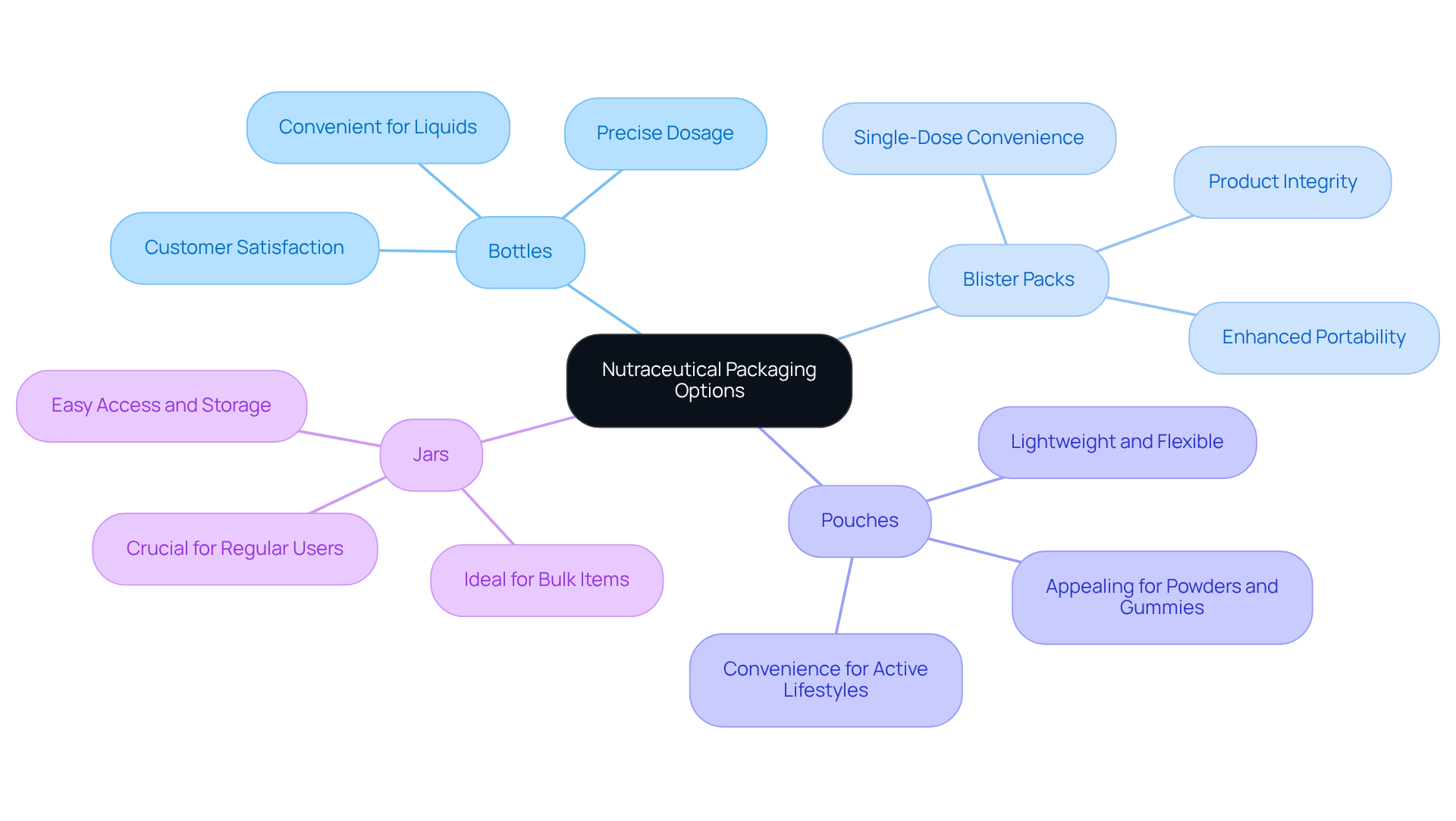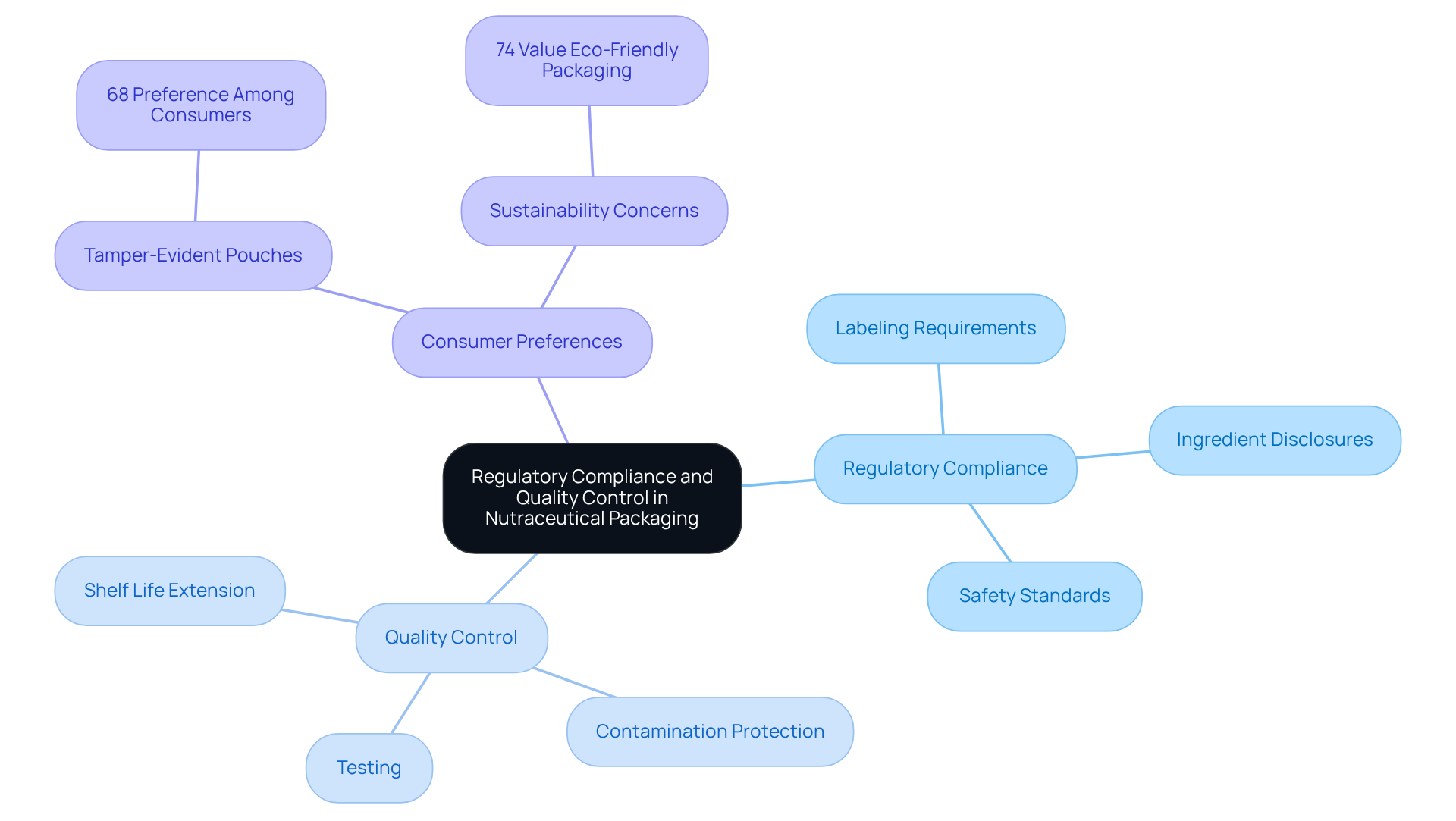Overview
Nutraceutical packaging options are crucial for maintaining product integrity and boosting market appeal. Key types include:
- Bottles
- Blister packs
- Pouches
- Jars
Each type is designed to meet specific consumer needs. Effective packaging safeguards the product while playing a pivotal role in branding and consumer engagement. This is evident in the growing trends towards sustainable materials and the rising demand for visually appealing designs that comply with regulatory standards. As the market evolves, businesses must prioritize quality packaging solutions to ensure reliability and foster consumer trust.
Introduction
Nutraceutical packaging is crucial in the health and wellness industry, not only protecting product integrity but also capturing consumers' attention in a saturated market.
As awareness of health products increases, the significance of packaging that embodies quality and sustainability becomes paramount, aligning with consumer values and preferences.
However, with evolving regulations and the demand for innovative materials, brands face the challenge of navigating the complexities of packaging.
How can they ensure compliance while maintaining consumer trust?
Define Nutraceutical Packaging: Key Concepts and Importance
Nutraceutical containers represent specialized solutions crafted for dietary supplements and health items, fulfilling dual roles: safeguarding item integrity and enhancing market appeal. The key concepts in this domain encompass:
- Functionality, which guarantees that the container preserves the item's effectiveness.
- Aesthetics, which significantly influences buyer attraction.
Efficient wrapping not only conveys the advantages of the item clearly but also adheres to regulatory standards and distinguishes offerings in a crowded marketplace. As buyer awareness increases, the impact of product presentation on purchasing decisions becomes increasingly apparent, underscoring its importance as an essential element of product strategy within the nutraceutical sector.
Projections for 2025 indicate a notable shift towards sustainable materials and innovative designs that not only satisfy consumer expectations for safety and quality but also align with their values, thereby further influencing purchasing behavior.

Explore the Evolution of Nutraceutical Packaging: Historical Context
The evolution of nutraceutical containers signifies a remarkable transformation from the early days when dietary supplements were sold in bulk without branding. As the market expanded, the necessity for containers that not only safeguarded products but also communicated their benefits became evident. The introduction of innovative materials, such as biodegradable plastics and child-resistant closures, marked pivotal advancements within the industry. Over time, heightened consumer awareness regarding health and wellness has intensified the demand for containers that are both informative and visually appealing.
Today, packaging options are not merely a protective layer; they serve as a vital marketing tool that embodies the brand's identity and values while ensuring product safety and compliance with regulatory standards. The global nutraceutical container market is projected to reach approximately USD 5.30 billion by 2025, highlighting the increasing emphasis on health and wellness.
Key players in the industry are progressively adopting sustainable practices, with biodegradable and recyclable materials gaining traction. This shift not only meets public demand for eco-friendly options but also enhances brand value in a competitive landscape.

Identify Leading Packaging Options for Nutraceuticals: Examples and Applications
The primary packaging options for nutraceuticals encompass:
- Bottles
- Blister packs
- Pouches
- Jars
Each is tailored to specific requirements and consumer preferences. Bottles are particularly favored for liquid supplements, as they provide convenience and precise dosage—elements essential for customer satisfaction. Blister packs shine in delivering single-dose convenience, ensuring product integrity while enhancing portability for active lifestyles. Pouches, commonly used for powders and gummies, are both lightweight and flexible, appealing to individuals who prioritize convenience. Jars are ideal for bulk items, facilitating easy access and storage, which is crucial for regular users. Each container type not only fulfills functional needs but also significantly impacts branding and customer engagement. Notably, 60% of consumers are willing to pay more for containers that are easy to open and store, and 60 to 70 percent are prepared to invest in sustainable options when marketed as eco-friendly. Therefore, producers must strategically select materials that resonate with their target audience while enhancing product appeal.
Furthermore, the nutraceuticals sector is projected to grow from USD 463.5 billion in 2025 to USD 762.3 billion by 2035, underscoring the increasing importance of effective packaging options. Additionally, the rigid container market for nutraceuticals is anticipated to expand at a CAGR of 6.3% from 2025 to 2035, emphasizing the necessity of selecting appropriate packaging options in a burgeoning market. Manufacturers aiming to align with current trends must also incorporate research-backed formulations and sustainable sourcing into their product decisions.

Examine Regulatory Compliance and Quality Control in Nutraceutical Packaging
Regulatory compliance in nutraceutical containers is paramount, requiring strict adherence to guidelines established by authorities such as the FDA and FTC. These regulations dictate essential aspects, including:
- Labeling requirements
- Ingredient disclosures
- Safety standards that containers must meet
Equally important is quality control, which ensures that wrapping materials do not compromise the product's integrity. Manufacturers are obligated to conduct rigorous testing to confirm that their containers effectively protect against contamination and degradation. For instance, compliant nutraceutical packaging can extend shelf life by up to 30% and enhance customer trust by 28%, underscoring the critical role of quality control measures.
Furthermore, 68% of shoppers prefer tamper-evident pouches for safety, illustrating the direct link between quality control and buyer confidence. By prioritizing compliance and quality control, companies not only safeguard public health but also enhance their credibility in the market, fostering trust and loyalty among consumers. As noted by industry experts, 'Compliant nutraceutical containers are a safeguard for brands and consumers' (source needed), highlighting the significance of these practices in today's competitive landscape.
Additionally, the FDA's limited inspections and enforcement capabilities pose challenges for manufacturers, making adherence to regulations even more vital. Notably, 25% of nutraceutical brands encounter compliance violations, which can result in substantial financial repercussions, further emphasizing the necessity of maintaining high standards in packaging options.

Conclusion
Nutraceutical packaging is a pivotal component of the health and wellness sector, offering essential protection and marketing benefits for dietary supplements. As consumer awareness and preferences evolve, the importance of effective packaging has become increasingly apparent. It not only preserves product integrity but also enhances visual appeal, which is crucial for attracting buyers and distinguishing products in a competitive market.
This article delves into various facets of nutraceutical packaging, encompassing its historical evolution, leading packaging options, and the critical importance of regulatory compliance and quality control. Significant points underscore the transition towards sustainable materials, the variety of packaging types available, and the imperative for adherence to safety standards. Furthermore, the expanding market for nutraceuticals highlights the necessity for strategic packaging choices that align with consumers’ values and expectations.
In light of these insights, it is evident that the role of packaging in the nutraceutical industry transcends mere functionality. It serves as a potent tool that influences purchasing decisions and cultivates consumer trust. As the market continues to grow, manufacturers must prioritize innovative, compliant, and sustainable packaging solutions to meet the demands of a discerning audience and bolster their brand's credibility in an increasingly competitive landscape.
Frequently Asked Questions
What is nutraceutical packaging?
Nutraceutical packaging refers to specialized containers designed for dietary supplements and health products, aimed at protecting item integrity and enhancing market appeal.
What are the key concepts of nutraceutical packaging?
The key concepts include functionality, which ensures the container preserves the item's effectiveness, and aesthetics, which significantly influences buyer attraction.
Why is efficient wrapping important in nutraceutical packaging?
Efficient wrapping is important because it clearly conveys the benefits of the product, adheres to regulatory standards, and helps distinguish offerings in a competitive market.
How does product presentation affect purchasing decisions in the nutraceutical sector?
As buyer awareness increases, the impact of product presentation on purchasing decisions becomes more significant, highlighting its importance as a critical element of product strategy.
What trends are projected for nutraceutical packaging by 2025?
Projections for 2025 indicate a shift towards sustainable materials and innovative designs that meet consumer expectations for safety and quality while aligning with their values, influencing purchasing behavior.




